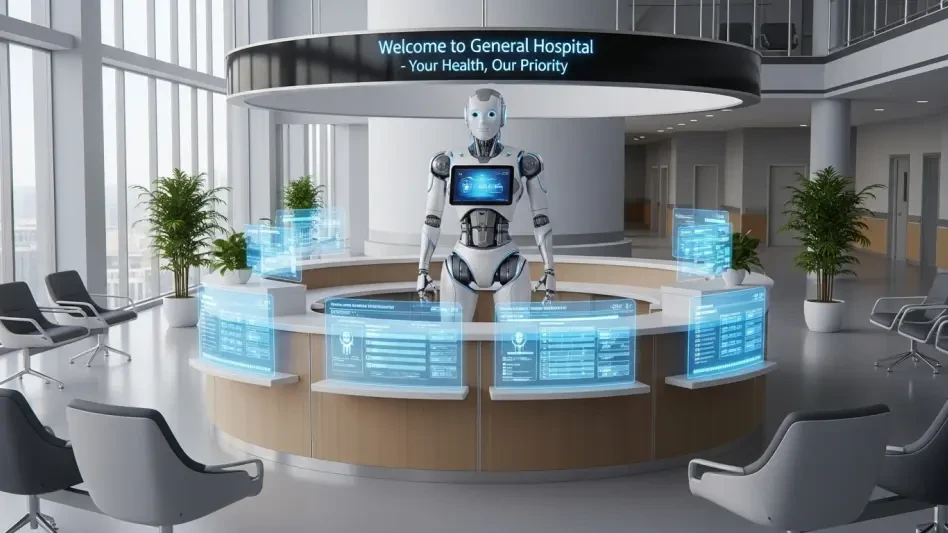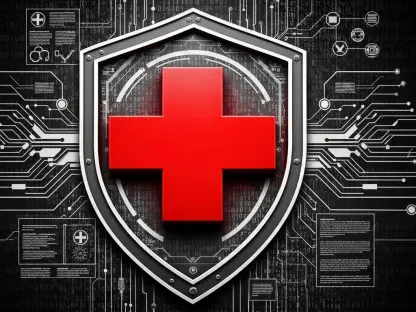The healthcare industry stands at a pivotal moment, grappling with an unprecedented challenge: can its aging IT infrastructure sustain the explosive growth of artificial intelligence (AI) and the Internet of Medical Things (IoMT)? As hospitals and health systems pour billions into cutting-edge technologies to revolutionize patient care, a staggering gap emerges—many lack the foundational systems to support these innovations. This disconnect risks not only wasted investments but also the promise of improved outcomes for millions of patients. With technology reshaping care delivery at a breakneck pace, the urgency to address this infrastructure crisis has never been greater, setting the stage for a critical examination of readiness and resilience in healthcare IT.
The Current State of Healthcare IT Infrastructure
Healthcare IT infrastructure today is a patchwork of legacy systems and modern solutions, often struggling to keep pace with rapid technological advancements. Many hospitals rely on outdated networks that were designed for simpler tasks, not the complex demands of AI-driven analytics or real-time data processing from connected devices. This mismatch creates bottlenecks that hinder operational efficiency and the ability to deliver timely patient care, exposing a fundamental weakness in the industry’s foundation.
Key stakeholders, including hospitals, tech providers, and regulatory bodies, are increasingly aware of the critical role infrastructure plays in sustaining innovation. The integration of AI and IoMT is already transforming diagnostics and remote monitoring, but without robust systems to support data flow and storage, these tools cannot reach their full potential. Hospitals, in particular, face the dual challenge of maintaining day-to-day operations while attempting to modernize under tight budgets and resource constraints.
The significance of infrastructure extends beyond technology—it directly impacts patient outcomes and care quality. A reliable IT backbone ensures seamless communication between devices, secure data sharing, and uninterrupted access to electronic health records. As the industry moves toward more connected and data-intensive models, the readiness of these systems will determine whether healthcare can truly leverage innovation for better results.
The Surge of AI and IoMT in Healthcare
Emerging Technologies and Market Drivers
The healthcare sector is witnessing a technological renaissance, driven by AI and IoMT, which are redefining how care is delivered and managed. AI-powered analytics enable predictive modeling for disease outbreaks and personalized treatment plans, while IoMT devices, such as smart inhalers and wearable monitors, provide real-time patient data. These tools are pushing the boundaries of what’s possible, allowing providers to intervene earlier and more effectively.
A significant driver behind this surge is the shift toward distributed, patient-centric care models. Remote patient monitoring and telemedicine are no longer niche offerings but essential components of modern healthcare, especially in underserved or rural areas. This evolution demands a vast network of connected devices and robust systems to handle the influx of data, challenging traditional infrastructure to adapt to a more decentralized approach.
Wearable technology further amplifies this trend, empowering patients to take control of their health through continuous tracking of vital signs. As care moves beyond hospital walls, the pressure on IT systems to support seamless integration and data accuracy intensifies. These emerging technologies signal a future where healthcare is more proactive, but only if the underlying infrastructure can keep up with the pace of change.
Investment Trends and Growth Forecasts
Investment in healthcare technology is reaching staggering heights, reflecting the industry’s commitment to transformation. Projections estimate that AI investments will climb to $149 billion by 2030, while IoMT spending is expected to soar to $814 billion by 2032. These figures underscore the scale of ambition, as stakeholders bet on technology to address rising costs and improve care delivery.
Growth indicators also point to a seismic shift in healthcare delivery over the next several years. Remote patient monitoring, with investments projected to hit $78 billion by 2029, exemplifies how technology is extending care into homes and communities. Such financial commitments highlight the potential for innovation to enhance efficiency, reduce hospital readmissions, and elevate patient satisfaction on a global scale.
However, the impact of these investments hinges on infrastructure readiness. Without the capacity to process and secure vast amounts of data, the promise of AI and IoMT could falter, leading to inefficiencies and missed opportunities. The financial stakes are high, and the industry must align its technological aspirations with practical upgrades to ensure these forecasts translate into tangible benefits for patients and providers alike.
Critical Challenges Facing Healthcare Infrastructure
The rapid adoption of advanced technologies is exposing significant shortcomings in healthcare IT infrastructure, with inadequate bandwidth standing out as a primary concern. Many facilities still operate on 10-gigabit connections, far below the 100-gigabit capacity needed to support data-heavy AI applications and comprehensive analytics. This limitation slows down critical processes, from real-time diagnostics to electronic health record updates, jeopardizing both efficiency and care quality.
Outdated network models compound the issue, as they were not designed for the decentralized, device-heavy environments of modern healthcare. With limited internal IT resources, many organizations struggle to maintain or upgrade their systems, often relying on patchwork fixes that fail to address long-term needs. This gap risks rendering substantial technology investments ineffective, as the foundation cannot support the tools being deployed.
Potential solutions, such as infrastructure overhauls and partnerships with specialized providers, offer a path forward, though they require significant capital and strategic planning. Upgrading to high-capacity networks and adopting scalable architectures can mitigate bottlenecks, but the pace of change must accelerate. Addressing these challenges is not just a technical necessity but a strategic imperative to prevent wasted resources and ensure that innovation delivers on its promise.
Cybersecurity and Regulatory Demands in a Digital Era
As healthcare’s digital ecosystem expands with IoMT and edge computing, the attack surface for cyber threats grows exponentially, posing a major risk to patient data and system integrity. Connected devices, often spread across diverse locations, create multiple entry points for breaches, making traditional security measures insufficient. This heightened vulnerability demands a rethinking of how networks are protected in an increasingly complex landscape.
The shift to zero trust architecture and user-focused authentication marks a critical response to these challenges, prioritizing continuous verification over static defenses. By focusing on individual access rather than device security alone, healthcare organizations can better safeguard sensitive information, even as data processing moves to the edge. This approach reflects a broader recognition that cybersecurity must evolve alongside technological advancements to remain effective.
Regulatory compliance adds another layer of complexity, as laws governing data protection tighten in response to rising threats. Ensuring adherence to these standards while redesigning network architectures for distributed care is no small feat, yet it remains essential for maintaining trust and avoiding costly penalties. Balancing security innovation with legal obligations will be a defining factor in how well the industry navigates this digital era.
Future Outlook for Healthcare IT Infrastructure
Looking ahead, healthcare IT infrastructure is poised for transformation through innovative solutions like edge-based architectures, which bring data processing closer to the point of care. This approach reduces latency and enhances real-time decision-making, addressing some of the bandwidth and connectivity issues plaguing current systems. As adoption grows, it could redefine how hospitals manage the deluge of data from connected devices.
Managed service providers are also emerging as vital partners in this evolution, offering specialized expertise and scalable resources to organizations with limited internal capabilities. By outsourcing complex IT needs, healthcare providers can focus on their core mission while ensuring their infrastructure keeps pace with technological demands. This trend toward collaboration signals a pragmatic shift in addressing systemic gaps.
Global trends, such as rising patient expectations for seamless digital experiences, will further shape infrastructure planning, pushing for greater interoperability and accessibility. Potential disruptions from new technologies, like advanced AI algorithms or next-generation IoMT devices, could accelerate the need for modernization. The industry must remain agile, anticipating these shifts to build systems that are not only robust today but adaptable for tomorrow’s challenges.
Conclusion: Bridging the Infrastructure Gap for Better Care
Reflecting on the insights gathered, it becomes evident that a critical disparity exists between the ambitious investments in AI and IoMT and the readiness of healthcare IT infrastructure to support them. The challenges of insufficient bandwidth, outdated networks, and cybersecurity vulnerabilities pose substantial risks to the industry’s transformative goals. This gap threatens to undermine billions in funding and, more importantly, the potential for improved patient outcomes.
Moving forward, actionable steps emerge as essential to close this divide. Strategic investments in high-capacity connectivity and advanced security frameworks are identified as non-negotiable priorities to unlock the full potential of emerging technologies. Partnerships with managed service providers also stand out as a practical solution, enabling organizations to scale efficiently while focusing on care delivery.
Ultimately, the path ahead demands a commitment to modernization that matches the scale of technological ambition. By aligning infrastructure upgrades with evolving patient needs and global trends, the healthcare sector can ensure that innovation translates into meaningful progress. This focus on resilience and adaptability offers a blueprint for navigating the complexities of a digital future, paving the way for a system better equipped to serve communities worldwide.









